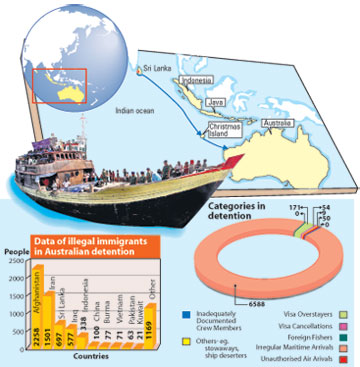| Australia has turned to Malaysia for a solution to the problem of Sri Lankan asylum seekers, or boat people, arriving on its shores.“Australia and Malaysia have agreed to transfer to Malaysia asylum seekers who enter Australian waters by boat,” according to Australian High Commissioner Kathy Klugman.
“The arrangement signals that Australia is shutting its doors to people smugglers. From now on, any person – including any Sri Lankan – who uses the services of people smugglers to travel to Australia by sea can be sent to Malaysia,” Ms. Klugman told the Sunday Times.
On May 7, Australian Prime Minister Julia Gillard and Malaysian Prime Minister Najib Tun Razak issued a joint statement outlining a cooperative transfer arrangement, under which any person who arrives in Australia in an irregular or illegal manner, by sea or air, could be transferred to Malaysia.
In return, Australia has agreed to take 4,000 “genuine refugees” living in Malaysia over a period of four years, as part of the global refugee intake.
According to Ms. Klugman, Sri Lankan boat people sent to Malaysia will have to join the queue of asylum seekers awaiting refugee status determination and resettlement. They will not be eligible for resettlement in Australia. Asylum seekers transferred to Malaysia under this arrangement will not be given preferential treatment over asylum seekers already in Malaysia, nor will they receive the treatment given at Christmas Island and other Australian immigration detention centres.
There are some 92,700 refugees and asylum seekers registered with the United Nations High Commissioner for Refugees (UNHCR) in Malaysia. Of this number, some 4,000 are of Sri Lankan origin.
This measure would help put people smugglers out of business and discourage asylum seekers from making the hazardous journey to Australia by boat, Ms. Klugman added.
In October 2009, Indonesian authorities intercepted a boat carrying 255 Sri Lankan asylum seekers bound for Australia. The passengers included 150 men, 29 women, 17 girls, and 14 boys. The same month, Australia’s Oceanic Viking vessel rescued 78 Sri Lankan boat people.
In 2009, a boat that left the eastern coast of Sri Lanka encountered storms in waters northwest of Australia, and 12 people drowned. Twenty-seven rescued persons were taken to Christmas Island.
In another boat tragedy, in December 2010, 27 refugees, including four infants, died when their wooden boat was destroyed in stormy seas off Christmas Island. Thirty persons were injured.
Last month, a boat with 81 Sri Lankans was intercepted, and the asylum seekers were taken to Christmas Island for processing.
“The deal with Malaysia means there’s no point in paying people smugglers to take you to Australia, because you will only end up in Malaysia, and lose all your money,” Ms. Klugman said. “Under this arrangement, people smugglers will lose business. The journey to Australia will only end up as a ride to Malaysia.”
In 2009, more than 40 boats – carrying more than 2,000 asylum seekers, mostly from Sri Lanka, Afghanistan, and Iraq – entered Australian waters. In 2010, a staggering 6,300 asylum seekers reached Australia aboard 130 boats.
Meanwhile, the Australian High Commission has recently ramped its presence at the Bandaranaike International Airport, and is working closely with Sri Lankan immigration and security officials to detect and stop what might be asylum seekers seeking to reach Australia by air.
 |
| Lankan boat people bound for Australia in the hope of a new life in that country will be relocated in Malaysia. (AFP file pic) |
According to the Australian Department of Immigration and Citizenship, up to April this year, there were 6,872 people in immigration detention, including 5,047 in immigration detention on the mainland, and 1,825 in immigration detention on Christmas Island.Of the 1,825 people in immigration detention on Christmas Island, 242 are children (under 18 years).
There are 697 Sri Lankans in Australian immigration detention centres, in the mainland and on Christmas Island. They include 555 men, 70 women, and 72 children.
The International Organisation of Migration (IOM), based in Thailand, is running campaigns in Sri Lanka and around the world to alert potential asylum seekers to the risks of turning to people smugglers, rather than taking legal routes to other countries.
“The risks include unseaworthy boats, shipwreck, drowning at sea, exploitation by human traffickers, and possible detention on arrival and subsequent deportation,” IOM regional spokesperson J. Christopher Lowenstein-Lom told the Sunday Times.
Information campaigns would enable migrants to make informed choices, resulting in fewer people resorting to smugglers and more of them taking legal channels open for labour migration, he said.
Allegations against Malaysia, however, suggest the country is not seen as an inviting destination for asylum seekers.
Malaysia, which is not a signatory to the 1951 United Nations Refugee Convention, has a reputation for harsh immigration laws. In addition, asylum seekers held in Malaysia are not allowed legal work permits.
Allegations of overcrowding, unhygienic conditions, and medical negligence in detention camps have been levelled at Malaysia.
When the Sunday Times contacted the Malaysian High Commission in Colombo, a spokesperson declined to comment on either the recent Australia-Malaysia agreement nor the allegations.
A Sri Lankan Tamil national, who asked that his name be withheld, told the Sunday Times that he had been deported on three occasions, after illegally attempting to enter France, Switzerland, and Australia. He was among a group of persons arrested by the Sri Lankan Navy in 2009 while trying to flee to Australia.
“People pay lakhs of rupees not to end up in torture camps and live in poor conditions, with no hope of refugee status,” he told the Sunday Times. “We can depend on Western countries give us refugee status, and we can find jobs in those countries. We need to earn money in order to support our families,” he said.
According to the Sri Lankan Tamil, asylum seekers are charged from Rs. 500,000 to Rs. 1 million per person to be smuggled to another country. The money is non-refundable. |



